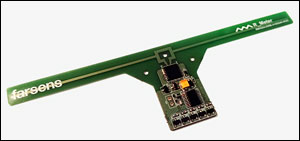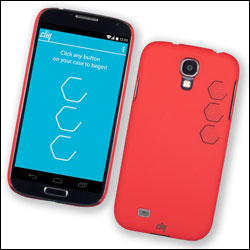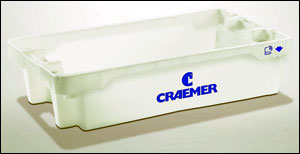The following are news announcements made during the past week by the following organizations:
Farsens;
iDevices;
Cliq Cases Inc.;
The Craemer Group; and
ams.
Farsens Offers Wireless, Battery-Free Ohm-Measuring Tag for Sensor Development
Farsens, a Spanish developer of RFID sensors, has announced the R-Meter, a wireless, battery-free sensor tag based on Farsens’ proprietary RFID integrated circuit—the ANDY100—that lets companies measure the resistance value of the device under test (DUT). The R-Meter is compatible with commercial ultrahigh-frequency (UHF) EPC Gen 2 RFID readers, and is designed for companies that want to develop their own sensors, according to Mikel Choperena, Farsens’ product development manager. The R-Meter is capable of measuring the resistance values of any device connected to it, Farsens reports, at a range of 100 to 500K ohms with an accuracy of ±3 percent. Built in a compact PCB format, it also offers an extended operation range from 10Ω to 10MΩ, with an accuracy of ±7 percent. The idea, Choperena says, is to use the resistance-dependent sensors of a company’s preference, and to make them wireless and battery-free instead of sticking to the sensor references already available in Farsens’ portfolio. Thermistors, soil-moisture sensors and ambient light sensors that use a light-dependent resistor (LDR) are just some of the sensors that users can employ in conjunction with the R-Meter. These RFID-resistance monitor tags are compatible with commercial UHF EPC Gen 2 RFID readers. The R-Meter is available in a variety of antenna designs and sizes, depending on the specific application, and can be encapsulated in an IP67 or IP68 casing for use in harsh environments. The sensor tag can operate in temperatures ranging from -30 degrees to +85 degrees Celsius (-22 degrees to +185 degrees Fahrenheit) and has a communication range of 1.5 meters (5 feet). Tag requires no battery, the company notes, though adding one can increase the tag’s communication range. The R-Meter features 96 bits of Electronic Product Code (EPC) memory and operates in the 860 to 960 MHz frequency range. “We know that end users may require a different transducer model for their applications—say, a different temperature range, different accuracy or any other characteristic,” Choperena explains. “There are so many transducers available in the market that we want to offer our customers the possibility of developing their own battery-free sensor tag just by selecting a proper transducer. The rest is done by the R-Meter. The only limitation when selecting the sensor is that it needs to be a resistance-dependent sensor. The R-Meter will measure the resistance of the transducer so the software of the reader will receive the resistance value as if you were reading the sensor directly.”
iDevices Markets Bluetooth Beacons
iDevices has announced that its custom software stack for Broadcom‘s Wireless Internet Connectivity for Embedded Devices (WICED) family of smart, Bluetooth-enabled chips now supports Apple‘s iBeacon platform. In addition, iDevices has launched a Bluetooth beacon with integrated Broadcom WICED Smart chips and iDevices firmware. Apple introduced its iBeacon platform last year (see Companies Deliver New Apps For Bluetooth Beacons), which—similar to Bluetooth beacons supported by Android cell phones and tablets—uses Bluetooth Low Energy (BLE) and geofencing, and consists of transmitters that can communicate with nearby iOS 7 devices. Approximately a year ago, iDevices announced the release of its custom module and software stack for Broadcom Bluetooth Smart chips, and the company is now offering the support of iBeacon functionality to engineers using the Broadcom WICED Smart BCM20732 or BCM20736 system-on-chip (SoC). Through the addition of iBeacon support for Broadcom Bluetooth Smart SoCs, iDevices reports, developers now have easy access to micro-locating functionality. The iDevices beacon comes with a battery pack requiring 2 AAA batteries (for an average lifespan of three to four months). The iDevices beacon also has a USB connector, so it can be operated without batteries by plugging the beacon into a standard Apple wall USB power adapter. Initial features of the iDevices beacon include multiple power options, a compact size, simple app integration, authentication and security options. According to the company, iDevices beacon can be strategically placed anywhere within a physical space to broadcast radio signals to smart devices within proximity of up to 150 feet. Consumers with an associated app installed on their phone will receive personalized microlocation-based notifications if they walk within proximity of the beacon, iDevices explains. Bluetooth beacon technology is often used at retail locations to provide in-store analytics, proximity marketing and contactless payments, iDevices notes, adding that the applications are endless. At the Consumer Electronic Show, to be held in Las Vegas, Nev., on Jan. 6-9, 2015, iDevices plans to install the beacons throughout its 40- by 45-foot booth, in order to provide attendees with product information, giveaways and exclusive content. The iDevices module development kit is available now, while the beacon is currently available for pre-order from the iDevices website for $50 (complete with a battery pack). The iDevices beacon is set to ship during the third quarter of 2014.
Cliq Announces NFC-powered Smartphone Case
Startup Cliq Cases Inc. has announced a new Near Field Communication (NFC)-enabled smartphone case, as well as its Kickstarter campaign. The Cliq case has three touch-sensitive buttons on the back that activate NFC tags—which, according to the company, can be programmed to trigger practically any action on the smartphone, such as launching the camera, flashlight or any other app, controlling music, sending a prewritten text, calling specific individuals or sharing location information in the event of an emergency. The NFC chip used in the Cliq case is NXP Semiconductors‘ NTAG 213, which contains 144 bytes of memory (see NXP Releases New NFC Tag Chips for New Applications). The three buttons can be programmed to carry out up to six commands, Cliq reports. The case is composed of polycarbonate, and is finished with a soft coating used on high-end electronics. The cases come in five colors—red, black, white, blue and orange—and are available for Samsung Galaxy S5, S4 and Note 3, Google Nexus 5, Motorola Moto X and LG G2 smartphones. The Kickstarter initiative was launched on May 13 with a goal of raising $40,000. The cases started at $20 apiece, but will cost $30 by the end of the campaign. To date, the campaign has obtained 473 backers and raised $12,244.
Craemer Unveils RFID-tagged Container for Fishing Industry
The Craemer Group, a European manufacturer of plastic pallets, wheelie bins and containers, has introduced a smart fish box with an integrated RFID transponder designed for the fishing industry. The RFID-enabled fish box, Craemer reports, is built to enable companies operating within the supply chain to identify, track and trace information about fish, fishing grounds, and the quality and size of a catch. The fish box can transparently track fish throughout the entire process, from when the fish is caught to the point of sale. The information collected via RFID flows directly into fish auction information systems that are designed to let potential buyers purchase the fish before a trawler arrives in the harbor, the company says, thereby saving time and ensuring that the fish is taken to its destination faster. The solution leverages an EPC Class 1 Gen 2 and ISO 18000-6C compliant transponder with an NXP Semiconductors RFID chip. It can operate in temperatures ranging from -20 degrees to +70 degrees Celsius (-4 degrees to +158 degrees Fahrenheit) and has a read range is up to 3 meters (9.8 feet), depending on the type of reader used. According to Craemer, fish boxes without RFID tags can be retrofitted at any time. In addition to the RFID technology, the fish boxes feature a new system that manages water drainage to the front side, as well as an optimized base geometry for quick and easy drainage. In addition, the fish box offers improved stackability and user-friendly handgrips. According to Craemer, the new boxes are fully compatible with all standard fish boxes currently available on the market.
Ams Wins Patent Lawsuit
Semiconductor firm ams has announced that it has won a last-instance verdict against Melexis, a manufacturer of advanced mixed signal semiconductors, sensor chips and programmable sensor IC systems, in the patent validity lawsuit Melexis launched with respect to the European Patent EP 0 916 074 B1 covering magnetic field position sensor products. According to ams, the German Federal Supreme Court, in Karlsruhe, Germany, recently issued a final verdict validating the patent, which is exclusively held by ams, and nullifying Melexis’ claim that the underlying contactless position sensor technology was not patentable. Given the patentability decision against Melexis, the existing first-instance verdict in the patent-infringement lawsuit against Melexis—and its German subsidiary, Melexis GmbH—is fully reinstated. This lawsuit covers magnetic field position sensor products and European Patent EP 0 916 074 B1. As a consequence, Melexis continues to carry the risk of financial damages for patent infringement being awarded to ams on the basis of the valid infringement verdict. “We are delighted by the Federal Supreme Court decision validating our patent which has been exclusively held by ams since 2003,” said Bernd Gessner, the executive VP and general manager of ams’ automotive business unit, in a prepared statement. “We are spending significant amounts of time, effort, and money to develop the technologies driving our products and will continue to vigorously defend our intellectual property (IP) against unauthorized use or infringement.”




